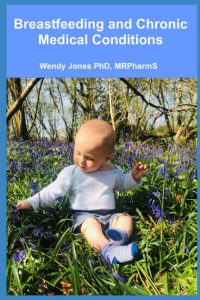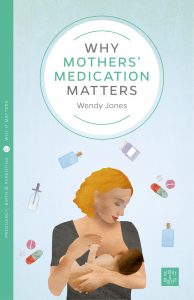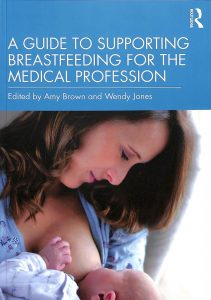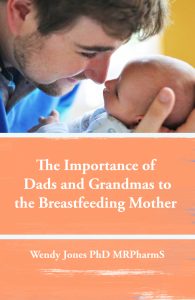Home » Articles posted by Wendy Jones (Page 2)
Author Archives: Wendy Jones
Breastfeeding during baby immunisation
As a new mum I remember how hard I found it holding my babies whilst they had their immunisations and hearing them cry. I always breastfed them as soon as I could to comfort them. I recalled a paper which mentioned using sucrose to relieve the pain during painful procedures. I recall it being in the BMJ but have it may not have been but may have been Abad (1996).
No one ever suggested that I could breastfeed during the immunisation because my babies were born back in the 1980s when breastfeeding was far from the norm after 6 weeks.
However, this paper has looked data from 10 trials, with results for 1,066 babies, mostly between one and six months old, following their normal immunisation schedule. They found that babies who were breastfed before and during routine childhood immunisations cried on average for 38 seconds less and had lower pain scores compared to babies not breastfed. Thirty-eight seconds may not sound a lot but to a mum witnessing her baby’s distress it definitely matters.
The authors noted “There is good evidence that breastfeeding during blood tests reduces pain in new-born babies (up to 28 days old), but the evidence was unclear for older babies. There were no evidence reviews looking at whether breastfeeding might help during painful procedures in babies aged one month to one year” which made me sad. It suggests that we still don’t consider breastfeeding is the norm and is about so much more than nutrition.
They mention that The good practice in postoperative and procedural pain management guideline from the Association of Paediatric Anaesthetists of Great Britain and Ireland, published in 2012, recommends that breastfeeding (along with swaddling, pacifiers, and sugar) should be considered for babies being vaccinated.
None of the included studies reported any adverse effects such as choking, gagging, spitting or coughing. No studies reported on the acceptability of breastfeeding, from the mothers’ or healthcare professionals’ perspective. The studies didn’t report on the practicalities of breastfeeding in the immunisation clinics but surely this isnt impossible to arrange?
So next time your baby needs an immunisation or you as a professional need to immunise a baby maybe this is something to think about?
References
Stevens B, Yamada J, Ohlsson A, Haliburton S, Shorkey A. Sucrose for analgesia in new-born infants undergoing painful procedures. Cochrane Database Syst Rev. 2016 Jul 16;7(7):CD001069. doi: 10.1002/14651858.CD001069.pub5. PMID: 27420164; PMCID: PMC6457867. https://pubmed.ncbi.nlm.nih.gov/27420164/
Abad F, Díaz NM, Domenech E, Robayna M, Rico J. Oral sweet solution reduces pain-related behaviour in preterm infants. Acta Paediatr. 1996 Jul;85(7):854-8. doi: 10.1111/j.1651-2227.1996.tb14167.x. PMID: 8819554.
The good practice in postoperative and procedural pain management guideline from the Association of Paediatric Anaesthetists of Great Britain and Ireland
https://www.apagbi.org.uk/news/considerations-acute-and-chronic-pain-management-children-paediatric-anaesthesia-tutorial
Harrison D, Reszel J, Bueno M, et al. Breastfeeding for procedural pain in infants beyond the neonatal period. Cochrane Database Syst Rev. 2016;10:CD011248.
NHR Evidence Breastfeeding reduces crying during baby immunisation https://evidence.nihr.ac.uk/alert/breastfeeding-reduces-crying-during-baby-immunisation/

Bowel cleansing before colonoscopy and breastfeeding
Just recently I have been contacted by several mothers who were told that they cant breastfeeding during the 24 hour period of bowel prep prior to a colonoscopy or for 24 hours following the procedure under sedation. This is not supported by research and understanding of the pharmacokinetics of the drugs used. It is also a potential risk in that the mother may develop blocked ducts or mastitis necessitating antibiotics if she is unable to express her milk, or in many cases hasn’t been advised to! Not all babies will drink from a bottle so may become dehydrated. Some babies are allergic to cow’s milk protein and may be compromised by 3 days of artificial formula. Hence this fact sheet on the bowel preparations generally used.
It is acceptable to breastfeed as normal during bowel prep. The mother should drink freely of the allowed clear fluids. Someone may be needed to look after the baby during rapid need to evacuate bowels – unless you have taken these products you cant begin to understand the urgency!
PDF of information available
https://breastfeeding-and-medication.co.uk/wp-content/uploads/2023/08/Moviprep-and-breastfeeding-1.pdf
An increasing number of breastfeeding mothers are having colonoscopies to investigate gut problems. The first stage of a colonoscopy is the use of a strong laxative and 24 hours of a fluid only diet to clear out the gut so that the professionals can see the gut in its entirety completely.
Many mothers worry that not eating for 24 hours will reduce their milk supply. Fasting does drop the supply a small amount for some women but frequent feeds seem to overcome problems. It is important to keep drinking the clear fluids which are allowed in order not to dehydrate.
From experience you may find that you need someone else in the house to take the baby urgently when you have to rush to the toilet – there is no waiting! You may find otherwise that you end up feeding whilst on the loo for practical reasons. The bowel washouts produce considerable urgency
Movicol®
One of the most commonly used laxative agents to clear the gut is Movicol ® otherwise known as polyethylene glycol- electrolyte solution. It is a saline laxative which is not absorbed from the gut but pulls water into the bowel to wash the contents out. Because it is not absorbed from the gut it cannot get into breastmilk and would not affect the baby.
MoviPrep®
This dual sachet product contains macrogol and electrolytes in 2 different sachets, Because it is not absorbed from the gut it cannot get into breastmilk and would not affect the baby.
Plenvu ®
This powder contains macrogol and electrolytes in sachets, Because it is not absorbed from the gut it cannot get into breastmilk and would not affect the baby.
Picolax®
Sodium picosulfate is not absorbed from the gastrointestinal tract, and its active metabolite, which is absorbed, is not detectable in breastmilk. Breastfeeding can continue as normal.
KleanPrep ®
KleanPrep contains macrogol 3350 , an osmotic laxative with a high molecular weigh and zero oral bioavailabilty. Like Moviprep it accumulates water into the GI tract, where it acts as a laxative. It would be very unlikely to enter the plasma of the mother, or milk.
Citramag®
The ingredients magnesium carbonate and citric acid will form an osmotic laxative by pulling water into the bowel and stimulating the bowel to evacuate. Poor oral absorption of magnesium make it unlikely that any will be absorbed from milk to affect the breastfed baby.
Senna
Senna is a stimulant laxative. Its key ingredient (anthraquinone), is believed to increase bowel activity due to secretion into the colon. It may produce abdominal cramps. In one study of 23 women who received Senokot none was detectable in their milk.[1] Of 15 mothers reporting loose stools, two infants had loose stools (Werthmann 1973). However, in a randomized, double-blind trial comparing Senokot tablets to placebo, of the women in the study, 126 breastfed their infants and took senna while 155 control mothers breastfed their infants. There was no difference in the percentages of infants in the active and control groups with loose stools or diarrhoea (Shelton 1980). In this study 8 doses were taken. In bowel preparation a single dose only is used.
Werthmann MW Jr, Krees SV. Quantitative excretion of Senokot in human breast milk. Med Ann Dist Columbia. 1973;42:4-5.
Shelton MG. Standardized senna in the management of constipation in the puerperium. A clinical trial. S Afr Med J. 1980;57:78-80.
Phosphate enema (Fleet®)
Sodium phosphate is a saline laxative which sucks water into the lumen of the bowel. Whilst some phosphate may get into the plasma, it is very unlikely to change the levels in milk. The oral bioavailabilty is zero to 20%. Use of phosphate enemas should not require interruption of breastfeeding (LactMed)
Bisacodyl (Dulcolax ®)
Bisacodyl is poorly absorbed from the gut (oral bioavailabilty <5%) and so reaches low levels in breastmilk. It is a stimulant laxative. Breastfeeding can continue as normal
For information on sedatives (midazolam, fentanyl, pethidine) used in colonoscopies see separate fact sheet . These also do not preclude normal breastfeeding as soon as the mother is awake and alert.
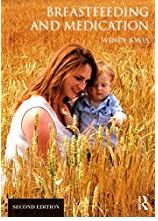
Bismuth subsalicylate (Pepto Bismol®) and Breastfeeding
Another of the frequently asked questions is the use of Pepto Bismol™ for indigestion or nausea
Pepto Bismol™ is marketed to relieve symptoms of upset stomach and diarrhoea. It’s active ingredient is bismuth subsalicylate, so it is related to aspirin which we avoid during breastfeeding at painkilling doses.
We are unsure if bismuth subsalicylate passes into a mother’s breast milk. Although bismuth salts are poorly absorbed from the maternal GI tract, significant levels of salicylate could be absorbed in theory. There are currently no reports of Reye’s syndrome in babies exposed to bismuth subsalicylate and it is normally only used very short term for stomach upset.
Breastfeeding mothers would be well advised to use alternative products to treat acute diarrhoea E.g. loperamide (Imodium®) if possible. However, In my experience of queries Pepto Bismol may be the only product available late at night and at weekends. The risk of short term use is probably low although this cannot be proved. The decision remains with the mother as to whether she wants to take it. Continuing to breastfeed during a stomach upset transfers antibodies to the baby to offer protection from the bacterial or viral condition.
It is also advertised to treat heartburn and indigestion for which there are many alternative remedies which are safe in breastfeeding, containing aluminium, calcium and magnesium carbonate.
See also https://www.e-lactancia.org/breastfeeding/bismuth-sub-oxysalicylate-2/synonym/
A very small amount of bismuth is absorbed from the gut: ≈ 0.1% (Tora 2020, Chen 2010, Boertz 2009, Dresow 1992, Nwokolo 1990: Bismuth is not absorbed into the systemic circulation of the mother, so it cannot be excreted in breast milk.
Salicylate is well absorbed (Nwokolo 1990), but is excreted in breast milk in negligible amounts, and the infant receives a relative dose of 1% (see Aspirin) and no cases of Reye’s syndrome have been reported after taking bismuth salicylate or other non-acetylated salicylate compounds.
Due to the otherwise minimum risk of Reye’s syndrome and the indiscriminate use of bismuth subsalicylate for treatment of gastroenteritis cannot be justifiable since most of gastroenteritis do not require medication instead a simply adequate hydration, a safer alternative should be desirable while breastfeeding. (Chen 2010, Nice 2000)

Betahistine and Breastfeeding
Betahistine (Serc ) is prescribed for dizzines and vestibular problems. There is little research available on it, because it isnt marketed in USA where most of the research studies are conducted. Anecdotally it is quite widely used without apparent problems. Observe the nursing baby for signs of drowsiness/ poor feeding in case
This is the entry I made for Breastfeeding and Medication 2018
“Betahistine is prescribed for vertigo, tinnitus and hearing loss associated with Ménière’s disease. There is no data on the amount that passes into breastmilk . It is an analogue of histamine and is believed to work by improving the microcirculationn of the labarynth. Side effects are reported to include gastro-intestinal disturbances, headache, pruritus and rashes. Prochlorperazine or cinnarazine would be the preferred to drug to treat dizziness. If betahistine use is perceived as essential the baby should be observed for drowsiness, GI disturbance and rash. There are no animal studies on use during lactation. Plasma levels of betahistine are very low. Plasma protein binding <5% (manufacturer SPC) Anecdotally it has been used without problems in breastfed babies “
See also https://www.e-lactancia.org/breastfeeding/betahistine/product/
Because of pharmacokinetic data it is likely excretion into breast milk, but though from very low plasma levels, usually below the detection threshold (100 pg/mL), so it is unlikely that the amount that could reach breast milk is significant.

Agnus Castus and Breastfeeding
I am not going to pretend that I am an expert on complimentary medicine but I am frequently asked about Agnus Castus for fertility and menstrual issues so am including this information based on the LactMed entry
Agnus Castus and Breastfeeding Fact Sheet
Other information may be found in :
- Herbs and Breastfeeding: References. https://kellymom.com/bf/can-ibreastfeed/herbs/herbal-ref/
- Herbal safety for nursing moms. https://kellymom.com/bf/can-ibreastfeed/herbs/herbal_safety/
- The Nursing Mother’s Herbal 2003 by Shelia Humphrey. Available from Amazon £9.99
Agnus-castus (Chasteberry) is from the berries of the chaste tree. The berries contain essential oils Chasteberry is often used for irregularities of the menstrual cycle, infertility, premenstrual complaints, and cyclical breast pain. [Dennehy 2006]
In low doses, chasteberry increases serum prolactin and it is a purported to increase milk supply (a galactogogue). [Javan 2017] however, no scientifically valid clinical trials support this use. Galactogogues should never replace evaluation and counselling on modifiable factors that affect milk production. [ Brodribb 2017, ACOG 2021] Some evidence indicates that high doses of chasteberry decrease serum prolactin and might decrease lactation. [ Eglash 2014 ] It has been used to decrease breastmilk oversupply in Persian traditional medicine.[Kabiri 2017]
In general, chasteberry is well tolerated. The most frequent adverse events are nausea, headache, gastrointestinal disturbances, menstrual disorders, acne, pruritus, and erythematous rash; however, all are mild and reversible. Among 352 nursing mothers given chasteberry tincture, 15 cases of pruritus, exanthema, urticaria, and some cases of early menstrual period occurred. Because of concerning safety data and possible lactation suppression, chasteberry should be avoided during lactation. [Daniele 2005]
See also https://www.e-lactancia.org/breastfeeding/vitex-agnus-castus/writing/
References
- Dennehy CE. The use of herbs and dietary supplements in gynaecology: an evidence-based review. J Midwifery Womens Health. 2006; 51:402–9. https://pubmed.ncbi.nlm.nih.gov/17081929/
- Javan R, Javadi B, Feyzabadi Z. Breastfeeding: A review of its physiology and galactogogue plants in view of traditional Persian medicine. Breastfeed Med. 2017; 12:401–9. https://pubmed.ncbi.nlm.nih.gov/28714737/
- Brodribb W. ABM Clinical Protocol #9. Use of galactogogues in initiating or augmenting maternal milk production, second revision 2018. Breastfeed Med. 2018; 13:307–14. https://pubmed.ncbi.nlm.nih.gov/29902083/
- Breastfeeding challenges: ACOG Committee Opinion, Number 820. Obstet Gynecol. 2021;137: e42–e53. https://pubmed.ncbi.nlm.nih.gov/33481531/
- Eglash A. Treatment of maternal hypergalactia. Breastfeed Med. 2014; 9:423–5 https://www.ncbi.nlm.nih.gov/pmc/articles/PMC4216483/
- Kabiri M, Kamalinejad M, Sohrabvand F, et al. Management of breast milk oversupply in traditional Persian medicine. J Evid Based Complementary Altern Med. 2017; 22:1044–50 https://www.ncbi.nlm.nih.gov/pmc/articles/PMC5871304/
- Daniele C, Thompson Coon J, Pittler MH, et al. Vitex agnus castus: A systematic review of adverse events. Drug Saf. 2005; 28:319–32. https://pubmed.ncbi.nlm.nih.gov/15783241/

Pain relief after a c section and Breastfeeding
This week I posted a link to a recently published paper which concluded that poor pain relief after a C section affected breastfeeding. https://consultqd.clevelandclinic.org/following-cesarean-delivery-postoperative-pain-affects-likelihood-of-in-hospital-breastfeeding/
I was saddened that we even had to think that pain would not be managed well for any mother, let alone when she was trying to initiate breastfeeding. It isn’t always easy to life a baby from a cot side crib when you have had surgery, let alone try to position a baby to achieve the perfect latch.
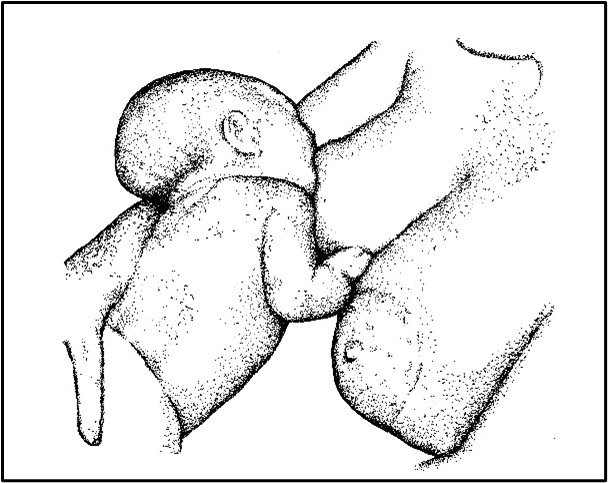
What surprised and horrified me was the mother’s who replied that they hadnt been given good pain relief when in hospital. They mentioned:
- not being told that more than paracetamol was available
- being offered only paracetamol and ibuprofen even when they needed more
- being forgotten on medication rounds,
- being discharged without sufficient pain relief.
This just isnt good enough and I would hope that everyone to whom this applies contacts the ward directly or through PALS that pain management plans are essential.
Pain relief which should be given to a breastfeeding mum in my opinion:
- In theatre a non steroidal anti inflammatory eg diclofenac as a suppository
- On the ward there should be available oramorph (subject to extensive first pass metabolism so little in milk)
- Regular use of an NSAID – ibuprofen, diclofenac or naproxen (low levels in milk) plus paracetamol See https://www.sps.nhs.uk/articles/using-nsaids-during-breastfeeding
- Codeine is no longer recommended but dihydrocodeine can be offered https://breastfeeding-and-medication.co.uk/thoughts/breastfeeding-and-codeine
- (https://breastfeeding-and-medication.co.uk/thoughts/dihydrocodeine-and-breastfeeding)
- Discharge packs should include the NSAID offered in hospital plus limited number of dihydrocodeine(usually 5 days supply) and if necessary although rarely oramorph. This may challenge the formulary in the hospital but can be overcome simply with care and thought for the patient.
- All opioids can cause nausea and dizziness but almost invariably cause constipation so it is wise to commence stool softeners like lactulose and/or docusate both of which are compatible with breastfeeding as they don’t pass into milk.
- Breast milk oxycodone concentrations in mothers given oxycodone for post-Caesarean delivery pain management. https://bpspubs.onlinelibrary.wiley.com/doi/10.1111/bcp.16008
NO WOMAN SHOULD BE LEFT IN PAIN BECAUSE SHE IS BREASTFEEDING

Breastfeeding after CT and MRI scans
Virtually every day I get messages from mothers and health visitors querying whether mothers can continue to breastfeed after CT and MRI scans. I was told that the national guidelines had been updated some years ago to align with RANZR guidelines . Sadly guidelines dont seem to have been updated by all radiology departments from my experience despite an update on 25.1.22 (see below)
I was lucky enough to work with Dr Gabrielle Cronin on this paper which was published in the Irish BMJ
Most mothers are advised to stop breastfeeding for 24 hours but there is no evidence for this as most contrast media are not orally bio available and have half lives which do not justify this duration.
On 25 January 2022 this was published by the Society of Radiologists :
https://www.sor.org/news/sor/sor-issues-joint-statement
The Society has issued guidance to reassure patients after recent research showed a lack of awareness among imaging teams on the most up-to-date evidence and guidance for breast-feeding patients who require a CT or MRI with contrast.The current Royal College of Radiologists (RCR) guidance published in 2019 relating to MR states:While no special precaution or cessation of breastfeeding is required the continuation or cessation of breastfeeding for 24 hours should be at the discretion of the lactating mother in consultation with the clinician.The SoR and RCR refer to the guidance published by The Royal Australian and New Zealand College of Radiologists (RANZCR) regarding CT contrast which says:Cessation of breast feeding or expression and discarding of breast milk after iodinated contrast media administration are not required.The Breastfeeding Network has summarised the advice of a number of expert organisations across the globe which is available on their website .The very small potential risk associated with absorption of contrast medium is considered insufficient to warrant suspending breastfeeding for any period following iodinated contrast agent administration.It is the view of the RCR and SoR that patients who wish to continue breastfeeding after being administered with contrast agent should be able to do so as there is no evidence of risk to the baby/child.Position statement – for patients. The Society of Radiographers (SoR) and the Royal College of Radiologists (RCR) are aware of conflicting opinions about whether patients who are administered with contrast agents – usually as part of a CT or MRI scan– can breast feed as part of their normal routine.It is the view of both the RCR and the SoR that patients who wish to continue breastfeeding after being administered with contrast agent – usually given in advance of a CT or MRI scan – should be able to do so as there is no evidence of risk to the baby/child. If you have any concerns please, speak with your radiographer or radiologist.
More information
https://www.breastfeedingnetwork.org.uk/ct/ https://www.breastfeedingnetwork.org.uk/mri/
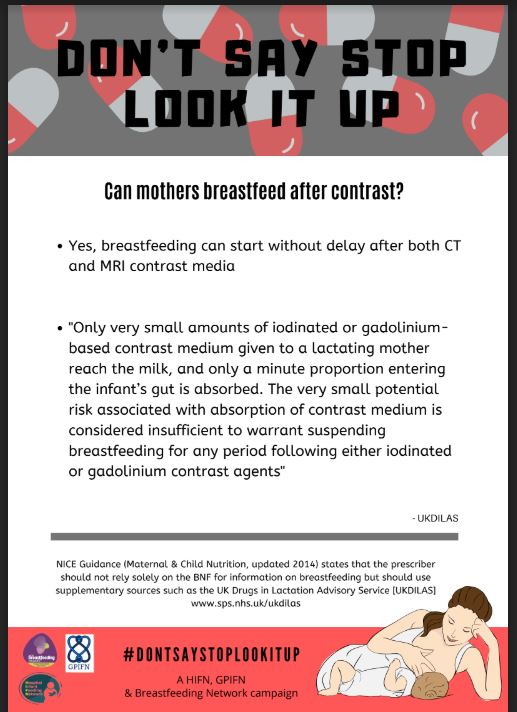

Ulipristal Acetate (EllaOne) as an emergency hormonal contraceptive and Breastfeeding
Ulipristal is used as an emergency contraceptive for up to 120 hours (5 days) after intercourse. It is a single tablet.
The manufacturer (patient information leaflet and SPC) recommends that breastfeeding should be avoided for 1 week after administration as it is present in milk.
This does not seem to be justified by pharmacokinetic data which supports the recommendations by expert sources that breastfeeding can continue as normal.
The specialist pharmacy service (October 2023) recommended that along with other hormonal method of emergency contraception it is compatible with breastfeeding if other methods are not appropriate ” Very limited evidence shows it is excreted in negligible levels into breast milk. It is highly bound to plasma proteins which limits its excretion into breast milk. Despite its long half-life, the single dose for emergency contraception is unlikely to result in accumulation in infants. Although, there is no information on infant serum levels, based on milk levels reported and the properties of ulipristal acetate, infant levels are predicted to be low and infant side effects would not be expected. No interruption of breastfeeding is considered necessary after taking a single dose. https://www.sps.nhs.uk/articles/using-emergency-contraception-during-breastfeeding
Pharmacokinetics
It is highly plasma protein bound (98-99.5%)
Relative Dose 0.8 – 1 % (significantly below 10% regarded as compatible with breastfeeding)
The manufacturer reports that after this medication was given to 12 breastfeeding women for emergency contraception mean levels in milk were measured as shown
| ulipristal level in breastmilk | |
| 24 hours | 22.7 ng/mL |
| 24-48 hours | 2.6ng/ml |
| 48-72 hours | 1.56 ng/mL |
| 72-96 hours | 1.04 ng/mL |
| 96-120 hours | 0.69 ng/mL |
The manufacturer did not report any neonatal outcomes as the infants in this report were not breastfed.
Recommendations on compatibility of breastfeeding
- No information is available on the clinical use of ulipristal during breastfeeding; however, amounts in milk are low. If ulipristal is required by the mother, it is not a reason to discontinue breastfeeding. Some older sources recommend withholding breastfeeding for 24 hours after a dose,[ Curtis KM, Jatlaoui TC, Tepper NK, et al. U.S. selected practice recommendations for contraceptive use, 2016. MMWR Recomm Rep. 2016;65:1–66]but this is no longer a requirement according to current FDA-approved labeling. https://www.ncbi.nlm.nih.gov/books/NBK500655/
- Intestinal absorption by the infant of the low dose excreted in breastmilk would be hindered, since oral bioavailability decreases up to 45% if administered with fat-rich foods, such as breastmilk.
Given the minimal excretion of the product in breastmilk and the absence of adverse effects recorded during breastfeeding, it is difficult to justify the recommendation proposed by other authors or health agencies such as CDC to interrupt breastfeeding for 24 hours (Curtis 2016 CDC) or 36 hours (Mansour 2009).
https://www.e-lactancia.org/breastfeeding/ulipristal-acetate-contraceptive/product/
- A single dose of 30mg ulipristal acetate is licensed to be taken within 120 hours (5 days) after unprotected intercourse or contraceptive failure. Ulipristal is not the preferred emergency contraceptive during breastfeeding, however, based on pharmacokinetic data, UKDILAS do not consider it necessary to withhold breastfeeding if a single dose has been taken. https://www.sps.nhs.uk/articles/emergency-contraception-and-breast-feeding/
Patient advice
- if vomiting occurs within 3 hours of taking a dose, a replacement dose should be taken;
- the next period may be early or late;
- seek medical attention promptly if any lower abdominal pain occurs because this could signify an ectopic pregnancy.
- Take a pregnancy test if the next menstrual period is delayed by more than 7 days, is lighter than usual, or is associated with abdominal pain which is not normal for a period pain
Further sources of information
Anti epilepsy medication and breastfeeding
A brief introduction to the information on the safety of anti epilepsy medication during breastfeeding. It does not include full information but you can find more in my book or by emailing me.
pdf of this factsheet available:

It is difficult to provide all the information on anti-epileptic medication in a fact sheet. If you need more information you might like to buy my book (Breastfeeding and Medication 2018)! Or you can email me (wendy@breastfeeding-and-medication.co.uk). The information below is taken briefly from text in my book.
It is absolutely imperative that you do not stop taking your medication in order to breastfeed. Your baby needs you to be seizure free. I cannot imagine the risk to your baby in the home if you are alone, maybe at a bus stop or back driving having been well controlled.
Many of the drugs can be taken by breastfeeding mothers. There will be a caution to observe the baby for drowsiness and poor feeding with each one. If you take more than one drug that risk would increase. This doesn’t mean you can’t breastfeed just that we need to keep that information in our minds and ensure that the baby is feeding and growing. If he/she isn’t growing we may need to consider options and support.
Many mothers ask if they can time breastfeeds so that the baby gets a minimal level of drug. Once you have taken any drug for more than 3 days it reaches a steady state with little fluctuation across the 24-hour period. This is essential as we don’t want a time of the day when your medication falls below an effective level. So, there are no peaks and troughs in which to feed or avoid feeding.
Some mothers know that their seizures may be precipitated by tiredness so they need to find ways of getting as much rest as possible. This might be using some formula or another adult bringing the baby to you to feed then caring for it. If you are very tired be very careful with co-sleeping as you may lose your natural awareness of the baby ( www.basisonline.org.uk has more information)
Different people require different medication to stabilise epilepsy. This fact sheet is one I have tried to write several times. There is so much to discuss with individual mothers, this can only be an introduction. Please message me if you need more information or to discuss the facts presented very briefly here.
Anti-epilepsy medication
- Lamotrigine (Lamictal ®): watch baby for drowsiness and any strange rash. If your dose
was increased in pregnancy you will need a blood test soon after birth and will probably
have your dose reduced. Lamotrigine is present in milk, but limited data suggests no harmful
effect on the infant. - Topirimate (Topamax®):Öhman et al 2002. observed five babies at delivery and followed
three of them through lactation. Two to three weeks after delivery two of the breastfed
infants had detectable but unquantifiable levels of topiramate and one had an undetectable
concentration; m/p ratios of around 0.86 were determined throughout the study period and
no adverse events noted. Observe for sedation, poor feeding and diarrhoea. - Levetiracetam(Keppra ®): Johannessen et al. (2005) studied eight women with maternal
doses of levetiracetam up to 3.5 g daily, which produced low levels in milk and no adverse effects in their breastfed infants. The babies of mothers taking levetiracetam should be monitored for drowsiness and adequate weight gain. - Vigabatrin (Sabril ®): This drug is used where control of seizures has not been achieved.
Tran et al. (1998) studied two mother and baby pairs. He estimated the maximum amount of vigabatrin that a suckling infant would ingest in a day is 3.6% and 1% of the weight-adjusted daily dose respectively. It irreversibly inactivates gamma-aminobutyric acid (GABA) and the effect of this on neonatal brains is unknown. However, it is used directly to control infant spasms. Observe for sedation - Carbamazepine (Tegretol ®): It reaches measurably detectable levels in infant serum but
below the therapeutic range. The infant should be monitored for jaundice, drowsiness and adequate weight gain as sedation, poor sucking and hepatic dysfunction have been
reported, although rarely. - Sodium valproate (Epilim): this drug is now more rarely seen due to its known
teratogenic effects (MHRA 2017). Low levels are found in breastmilk but theoretically it is
recommended that the baby should be monitored for jaundice and liver damage. - Phenytoin (Epanutin®): All studies of phenytoin show levels in breastmilk to be too low to cause difficulties for breastfed infants
References - Jones W Breastfeeding and Medication 2nd Ed 2018 . Routledge
- Veiby G, Engelsen BA, Gilhus NE, Early child development and exposure to antiepileptic
drugs prenatally and through breastfeeding:a prospective cohort study on children of
women with epilepsy, JAMA Neurol, 2013Nov;70(11):E1–E8. - Ohman I, Vitols S, Luef G, Söderfeldt B, Tomson T, Topiramate kinetics during delivery,
lactation, and in the neonate: preliminary observations, Epilepsia, 2002;43:1157–60. - Johannessen SI, Helde G, Brodtkorb E, Levetiracetam concentrations in serum and in
breastmilk at birth and during lactation, Epilepsia, 2005;46:775–7 - Tran A, O’Mahoney T, Rey E, Mai J, Mumford JP, Olive G, Vigabatrin: placental transfer in
vivo and excretion into breastmilk of the enantiomers, Br J Clin Pharmacol, 1998;45:409–11 - MHRA, Valproate and Developmental Disorders: New Alert Asking for Patient Review and
Further Consideration of Risk Minimisation Measures, MHRA, 2017, www.gov.uk/drugsafety-update/valproate-and-developmental-disorders-new-alert-asking-for-patient-reviewand-further-consideration-of-risk-minimisation-measures.

Antibiotics and Breastfeeding
Although we now try very hard to avoid prescribing antibiotics unless essential ( because of the risk that in the future we wont have antibiotics which are as effective against all infections), sometimes they are necessary. The use of antibiotics during breastfeeding often causes disquiet because most of them cause the baby to have loose bowel motions, sometimes tummy cramps, and sometimes vomiting. Is continuing to breastfeed actually causing harm and should feeding be interrupted? Do we need pre-biotics and probiotics to redress the balance in the baby’s gut?
It is hard to watch a baby in distress but it is important to remember that when we breastfeed during an infection we are also passing antibodies to that infection in breastmilk to protect the baby. Breastmilk contains all the factors to redress the balance and return the baby’s gut to its normal state far better than any probiotics derived from other sources, in my opinion.
But the ultimate choice is that of the breastfeeding mother.
January 2024 the MHRA issued guidance on fluoroquinolones : ” that fluoroquinolone antibiotics given systemically (by mouth, injection, or inhalation) must only be administered when no other antibiotics are appropriate for use, the Medicines and Healthcare products Regulatory Agency (MHRA) has announced. This means that fluoroquinolones should only be prescribed when other recommended antibiotics have failed, will not work due to resistance, or are unsafe to use in an individual patient.” https://www.gov.uk/government/news/mhra-introduces-new-restrictions-for-fluoroquinolone-antibiotics
Fluoroquinolone include ciprofloxacin, levofloxacin, moxifloxacin, and ofloxacin. If prescribed these as a first option please discuss with your prescriber. The MHRA guidance refers to use in adults only where no other antibiotic is available.
See also https://www.sps.nhs.uk/articles/using-metronidazole-during-breastfeeding
Metronidazole can be used during breastfeeding for most usual treatment courses. Recommendations apply to full term, healthy infants.
I hope that the information in this factsheet helps make that decision. Please email me if you want to discuss anything : wendy@breastfeeding-and-medication.co.uk
Antibiotics and breastfeeding factsheet pdf

Antibiotics are acknowledged to be overused which is one of the reasons that Multiple Resistant Staphylococcus aureus (MRSA) and Clostridium difficile have become more widespread. It is sensible to consider whether a mother needs to be treated with antibiotics before exposing both her and her breastfed baby. Babies exposed to antibiotics via their mother’s breastmilk may develop symptoms of colic, abdominal discomfort and diarrhoea. These are an inconvenience and not a reason to suspend breastfeeding. Research undertaken in Canada in 1993 (Ito et al. 1993) showed that 15% of women prescribed antibiotics chose not to take the medicine and continue to breastfeed, rather than expose their baby to a risk which they had been assured was minimal. By contrast, 7% stopped breastfeeding during therapy despite reassurance. The research team also examined the reporting of adverse effects by mothers made aware of potential diarrhoea in the child with antibiotics passing through breastmilk. Although more women warned of side effects reported clinical effects which they had noted and judged to be due to the medication, than those not made aware, the difference is not statistically significant (87% compared with 68%). No difference in compliance with the antibiotic regimen or breastfeeding pattern, were noted between the two groups (Taddio et al. 1995).
These follow recommendations from the doctor that the ‘infection’ may be self-limiting but if symptoms develop further or fail to resolve in the following 48 hours, then the course of antibiotics should be taken. Little et al. have suggested restricting the use in the treatment of otitis media, upper respiratory infection and sore throat ((Little 2002; 2005; 1997) beginning the public health message about reducing the use of antibiotics. It may also be useful in the management of mastitis.
References
• Abdellatif M e, Ghozy S, Kamel MG, Elawady SS Ghorab MMEAttia AW, Le Huyen TT, Duy DTVHirayama K, Huy NT. Association between exposure to macrolides and the development of infantile hypertrophic pyloric stenosis: a systematic review and meta-analysis. Eur J Pediatr. 2019 178(3):301-314.
• Hale T. Hale’s medications & mothers’ milk. 19th ed. New York, USA: : Springer Publishing 2021. • Ito S, Koren G, Einarson TR, Maternal non compliance with antibiotics during breastfeeding, Ann Pharmacother, 1993;27(1):40–42.
• Ito S, Koren G, Einarson TR. Maternal Noncompliance with Antibiotics during Breastfeeding. Ann Pharmacother 1993;27:40–2. doi:10.1177/106002809302700110 • Jones W Breastfeeding and Medication Routledge 2018
• Jones W How to advise women on the safe use of medicines while breastfeeding The Pharmaceutical Journal, PJ, 2021, 306 (7949) https://pharmaceuticaljournal.com/article/ld/how-to-advise-women-on-the-safe-use-of-medicines-whilebreastfeeding
• LactMed https://www.ncbi.nlm.nih.gov/books/NBK501922/ • Little P, Delayed prescribing of antibiotics for upper respiratory tract infection, BMJ, 2005;331(7512):301.
• Little P, Gould C, Moore M, Warner G, Dunleavey J, Williamson I, Predictors of poor outcome and benefits from antibiotics in children with acute otitis media: pragmatic randomised trial, BMJ, 2002;325(7354):22
• Little P, Williamson I, Warner G, Gould C, Gantley M, Kinmonth AL, Open randomised trial of prescribing strategies in managing sore throat, BMJ, 1997;314:722.
• Taddio A, Ito S, Einarson TR, Leeder JS, Koren G, Effect of counselling on maternal reporting of adverse effects in nursing infants exposed to antibiotics through breastmilk, Reprod

See also https://www.sps.nhs.uk/articles/using-tetracycline-antibiotics-during-breastfeeding
https://www.sps.nhs.uk/articles/using-macrolide-antibiotics-during-breastfeeding
https://www.sps.nhs.uk/articles/treating-impetigo-topically-during-breastfeeding
